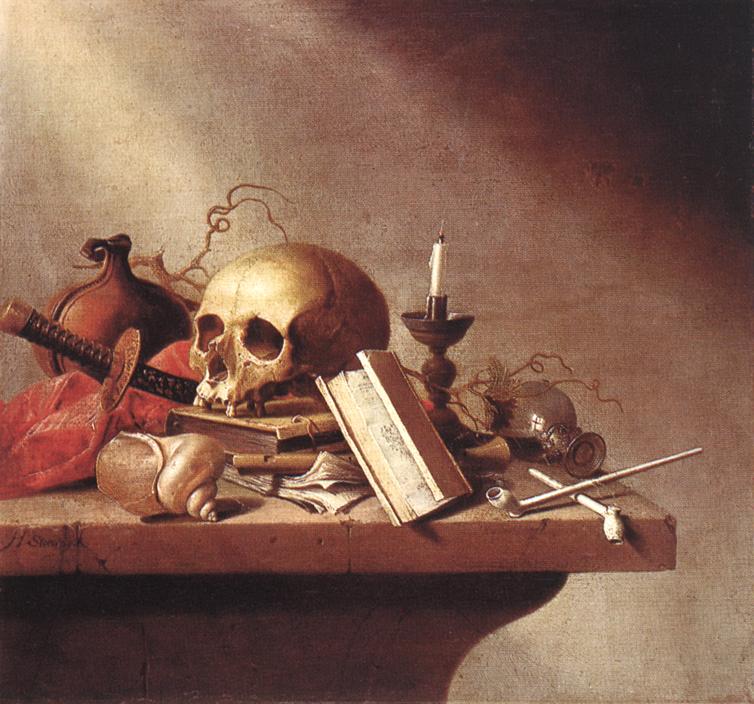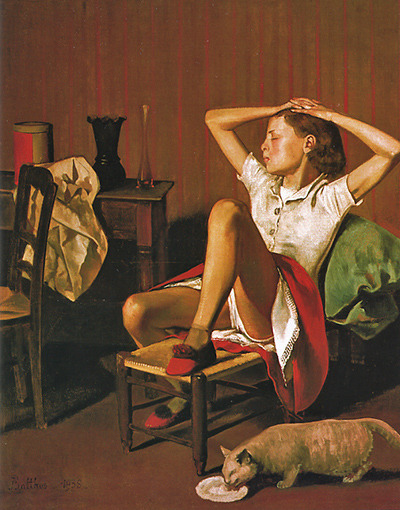.

Still-life with Rarities: Jan van der Heyden, 1712 (Szépmûvészeti Múzeum, Budapest)
We cannot draw closed the net in which we are caught...

Vanitas still-life: Harmen Steenwijck, c. 1640 (National Gallery, London)
Capitalism is a purely cultic religion, perhaps the most extreme that ever existed. In capitalism, things have a meaning only in their relationship to the cult; capitalism has no specific body of dogma, no theology. It is from this point of view that utilitarianism acquires its religious overtones.

The Carrot: Willem Frederik van Royen, 1699 (Märkisches Museum, Berlin)
This concretization of cult is connected with a second feature of capitalism: the permanence of the cult. Capitalism is the celebration of a cult sans rêve et sans merci. There are no "weekdays." There is no day that is not a feast day, in the terrible sense that all its sacred pomp is unfolded before us; each day commands the utter fealty of each worshiper.

Hunting still-life: Willem von Aelst, c. 1665 (private collection)
And third, the cult makes guilt pervasive. Capitalism is probably the first instance of a cult that creates guilt, not atonement. In this respect, this religious system is caught up in the headlong rush of a larger movement. A vast sense of guilt that is unable to find relief seizes on the cult, not to atone for this guilt but to make it universal, to hammer it into the conscious mind, so as once and for all to include God in the system of guilt and thereby awaken in Him an interest in the process of atonement. This atonement cannot then be expected from the cult itself, or from the reformation of this religion (which would need to be able to have recourse to some stable element in it), or even from the complete renouncement of this religion.

Vanitas still-life: Harmen Steenwijck, c. 1640 (Stedelijk Museum de Lakenhal, Leiden)

Its fourth feature is that its God must be hidden from it and may be addressed only when his guilt is at its zenith. This cult is celebrated before an unmatured deity; every idea, every conception of it offends against the secret of this immaturity.

Freud's theory, too, belongs to the hegemony of the priests of this cult. Its conception is capitalist through and through. By virtue of a profound analogy, which has still to be illuminated, what has been repressed, the idea of sin, is capital itself, which pays interest on the hell of the unconscious.
The paradigm of capitalist religious thought is magnificently formulated in Nietzsche's philosophy. The idea of the superman transposes the apocalyptic "leap" not into conversion, atonement, purification, and penance, but into an apparently steady, though in the final analysis explosive and discontinuous intensification. For this reason, intensification and development in the sense of non facit saltum are incompatible. The superman is the man who has arrived where he is without changing his ways; he is historical man who has grown up right through the sky. This breaking open of the heavens that was and is characterized (even for Nietzsche himself) by guilt in a religious sense was anticipated by Nietzsche. Marx is a similar case: the capitalism that refuses to change course becomes socialism by means of the simple and compound interest that are functions of Schuld (consider the demonic ambiguity of this word).

Count Willem II presides over the execution of the dishonest bailiff, 1336: Nicolaes von Galen, 1657 (Town Hall, Hasselt)
Capitalism is a religion of pure cult, without dogma.
Capitalism has developed as a parasite of Christianity in the West (this must be shown not just in the case of Calvinism, but in the other orthodox Christian churches), until it reached the point where Christianity's history is essentially that of its parasite -- that is to say, of capitalism.

Count Willem II presides over the execution of the dishonest bailiff, 1336 (detail): Nicolaes von Galen, 1657 (Town Hall, Hasselt)
non facit saltum=he cannot make the leap
Schuld=debt; guilt
Capitalism as Religion (fragment): Walter Benjamin, 1921, edited excerpt (translation by Rodney Livingstone in Selected Writings, Volume 1: 1913-1926, 1996)

2 comments:
What a great collection of artwork . . . and how often have I thought the same thing . . .
"until it reached the point where Christianity's history is essentially that of its parasite -- that is to say, of capitalism,"
esp. obvious today in the so-called religious right.
I love LOVE these painting. I love that girl in the red shoes with the cat, the carrot, that still life with "rarities."
A post I will revisit often . . .
In that case, Nin, let's just say this post was born to speak to you.
(Sometimes private conversations may be the most truthful.)
And oh, that carrot... a very strange dream-haunter.
This particular religion takes so many odd and spectral shapes: dead objects, empty skulls, carrots walking...
(Pops into mind that scary Rick Perry Planter-Head, speaking of natura morte.)
Post a Comment